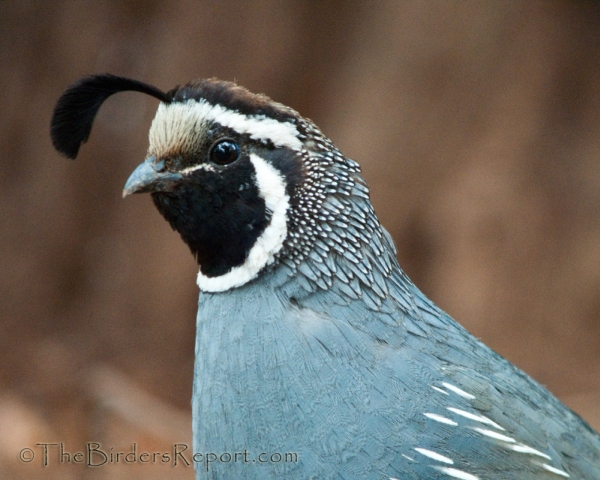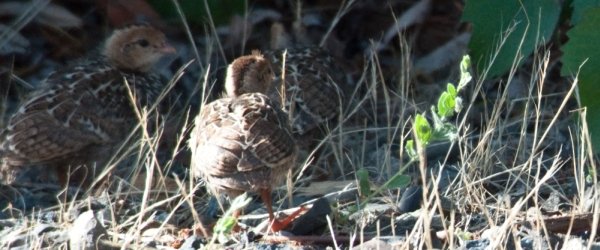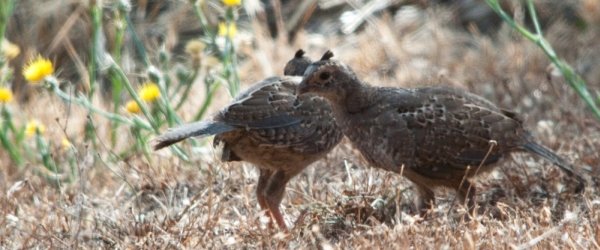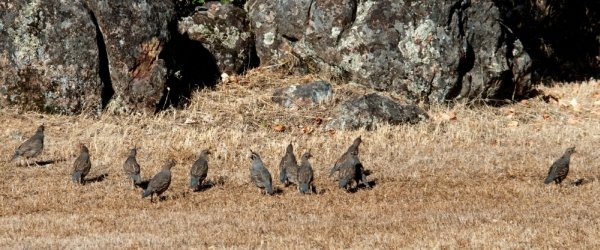The California Quail (Callipepla californica) is the California state bird, inhabiting scrub, broken chaparral and woodland edges primarily in California, Oregon, Washington and Baja California. They are part of a family of New World Quail which includes Gambel’s, Mountain, Scaled and Montezuma Quail, as well as the Northern Bobwhite. All New World Quail are highly gregarious, typically found in coveys or flocks except during breeding season.
In California, coveys break up and pairs begin forming in February or March, followed by nest building and egg laying in May or June. The nest is made by the hen lining a shallow hollow on the ground with some nearby vegetation. She will usually lay 12 to 17 eggs, averaging five per week1, before beginning incubation. Occasionally, larger clutches occur due to egg dumping by other females.
This nest was found in my friend Amber Galush’s yard and photographed by her.

The female usually does all the incubating, during which the male, pictured above (click on photos for full sized images), acts as sentinel during the day and generally remains in an off-the-ground roost overnight. Three weeks or so later the precocial young hatch synchronously. This synchronous hatching is accomplished by vocalizations and continuous clicking sounds culminating in the young giving a “hatching call” just before hatching2.
I have yet to discover a California Quail nest myself and have been unable to photograph the newly hatched young that immediately follow the parents and peck at the ground. The yolk sac of these precocial hatched young is absorbed by the second week when the chick has learned how to forage. At this age, they are also able to make short flights, a highly desirable trait for game birds.
I witnessed some chicks crossing the road with their parents a couple of years ago and snapped this photo. My guess is that these chicks are about five weeks old. They are fully feathered but still have down on their heads.
During the first two weeks of life the chicks are unable to adequately regulate their body temperature and are brooded primarily by the female pictured below. She will brood them at night and in early morning to prevent chilling or overheating.
When emerging to feed, the young follow their parents to food, attracted by contact calls usually given by the female while the male stands sentinel. The family stays very close to cover for several weeks, getting bolder as the young develop.
The family group pictured below has been visiting my yard recently. You can see two adult males, one in the middle and one on the right side of the screen and an adult female running up to the foraging group from the cover at the edge of the yard. You can see that they forage much like chickens, eating seeds, leaves, and flowers from grasses, shrubs, and trees as well as insects.
httpv://youtu.be/dzb-2SrSgi8
Looking at this photo of the chicks I took just four days before the video, it appears that they are going through their prebasic molt, making them at least seven weeks old. Note the down still on the head being replaced by feathers around the eye of the chick in the foreground.
In the group photo taken four days later of the family in the video, the chicks are completely feathered, leading me to believe it is a different family.
Two or more families of quail sometimes merge their young into aggregate groups which include the chicks and their parents2. On my way home tonight I saw three separate family groups, each with at least four adult birds and several young. These could be the beginning of the formation of coveys, post breeding season flocks that form when the chicks become independent at about three months old.
These coveys usually range is size from 27 to 73 individuals but researchers have suggested that in arid areas, larger groups are drawn to the same water source, thereby producing large, stable coveys2.
California Quail will chose to run from danger rather than fly but they will flush if forced and take flight to the nearest cover. When a large number of quail are flushed from a location unknown to you, it can be alarming. The sound, like an explosion, of all those wings flapping, can give you quite a scare.
The birds scatter, sometimes in different directions. This phenomenon can lead to an “assembly or rally call” which is often given when individuals become separated. During non-breeding season the call initiates the covey’s departure from the roosting site. In spring, the male seeking a mate will give a single note “advertisement call” as in the beginning of the recording linked above.
California Quail, being ground nesting game birds, have many predators which are assumed to be the primary cause of the specie’s mortality. Their main aerial predators are the Cooper’s Hawk and Sharp-shinned Hawk, but they are also taken by Red-tailed Hawks, Northern Harriers, Prairie Falcons and American Kestrels.
In addition to these aerial predators, their eggs and young are often taken by squirrels, gray foxes, house cats, coyotes, gopher snakes, rattlesnakes, raccoons, American Crows and Western Scrub-Jays. Let us also not forget the two-legged predator with a shotgun.
The quail’s only defenses consist of sentinel behavior by the male, alarm calls and retreat into the brush.
This is the reason that you will almost always find the male California Quail standing guard, usually perched atop a rock or other high vantage point, watching over his family or covey.
References:
1 Baicich, Paul J. and Harrison, Colin J. O. (2005), Nests, Eggs, and Nestlings of North American Birds, Princeton: Princeton University Press



















Larry, you always have such great posts!
I’ve been privileged to have found several California Quail nests – always by accident – flushing a female from a clump of vegetation while out birding. I’ve enjoyed watching chicks grow-up in my backyard in Idaho, Utah, and Arizona (Gambel’s Quail in AZ). There always seems to be a male quail designated as the dedicated safety observer while the females and chicks feed. Your information about the forming of covey’s matches my observations perfectly.
Nice post. I’ve only ever seen California Quail once but they’re great birds.
@Carrie: that puts you one ahead of me!
Love this post. My question is why everyone thinks the bird says “Chicago.” Is there no suitable California place name that would serve to stand in?
@Corey – I’ve never heard that quail say “Chicago” until I saw your comment, but that does fit extremely well. It has the right cadence.
@Robert: It does sound right but there must be a California alternative. How about “Francisco” as in the second word of San Francisco?
@Robert thank you very much. I’m sure you have probably been startled by a flock of quail too. The first time it happened to me, it scared the heck out of me!
@Carrie they are very cool birds and I love having them around
@Jochen come back to the western U.S. and I’ll be happy to show you some
@Corey I’ve racked my brain to come up with a California town to match that call but to no avail. I have always known the call as “Chicago”
I live in the southern interior of British Columbia near the US border. We have at leasat a hundred california Quail in our yard all year round. I love them. I photograph them whenever I can because they are so amazing and beautiful. thanks for posting quail!
Have heard quail making a clicking sound. Can’t figure if it is a call or a warning.